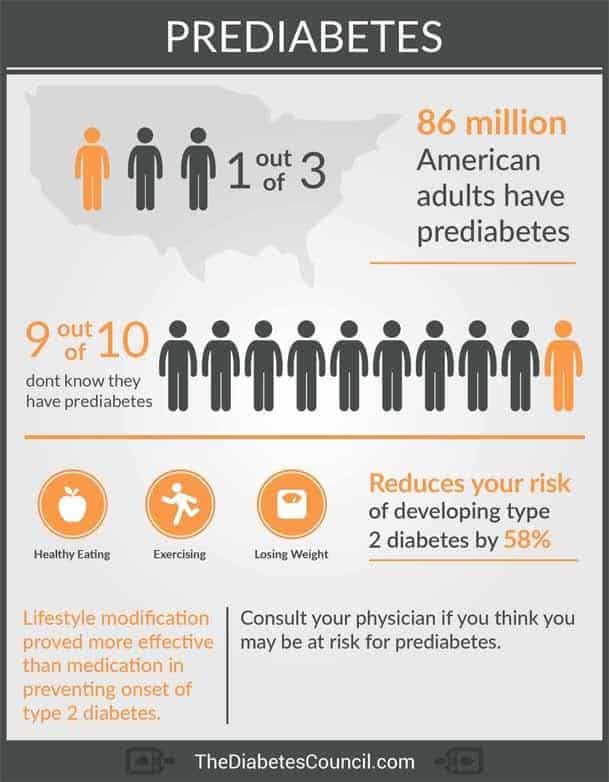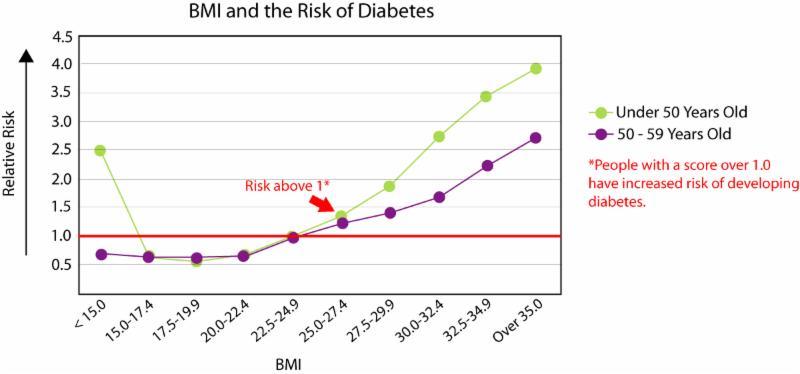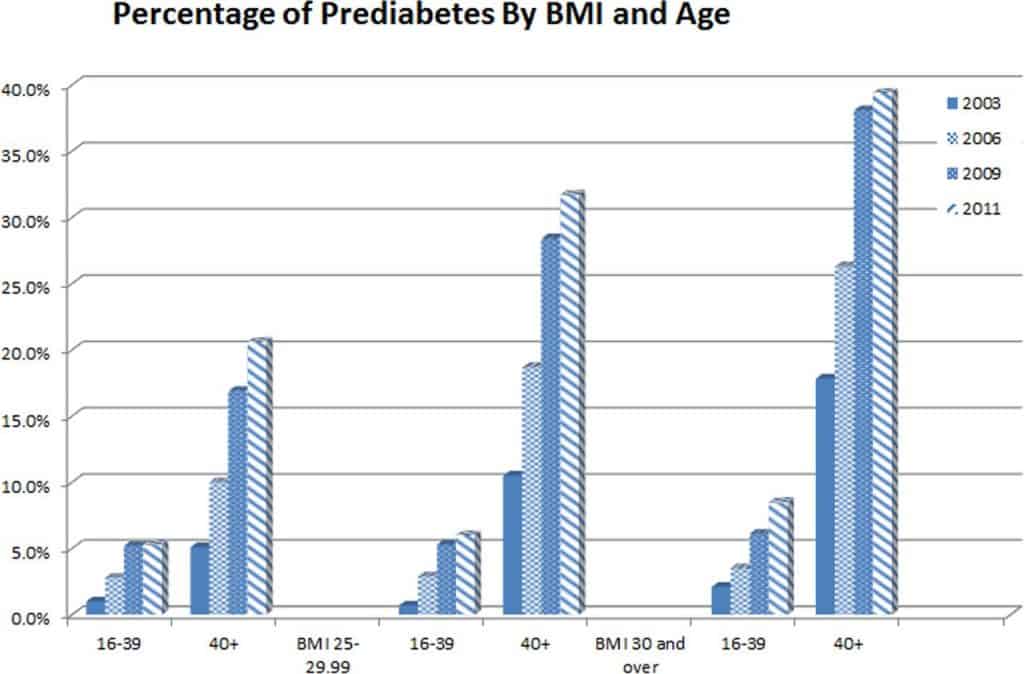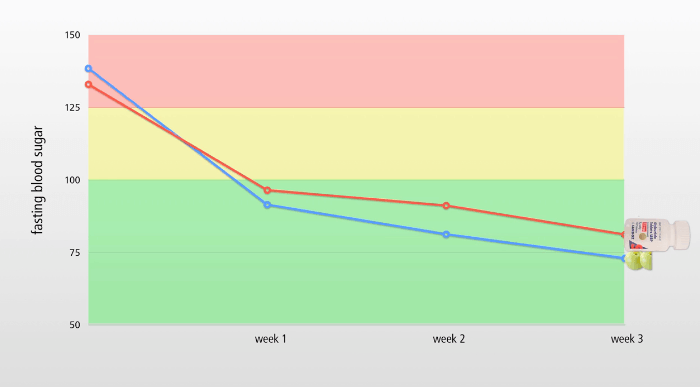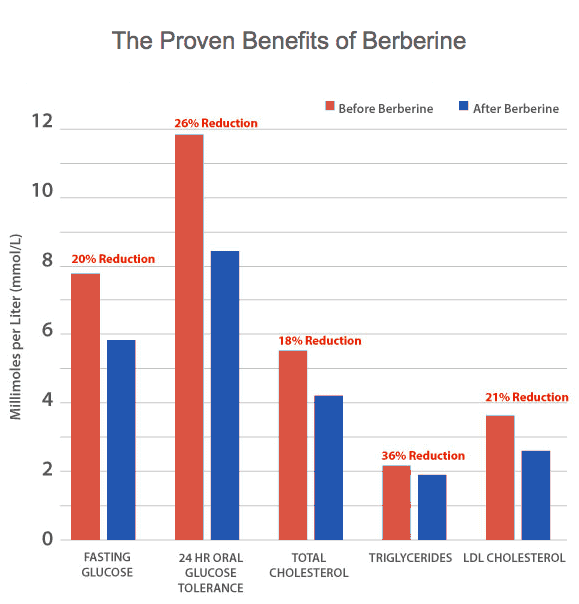Take the Prediabetes Quiz. 1 of 3 Americans Are Prediabetic. Are You?
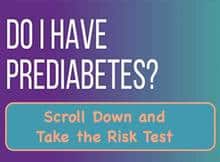
Take the quick Prediabetes Quiz to see if you’re at risk, and learn 9 very effective interventions to dramatically lower your blood sugar levels. Your blood sugar numbers can predict how long you’ll live.
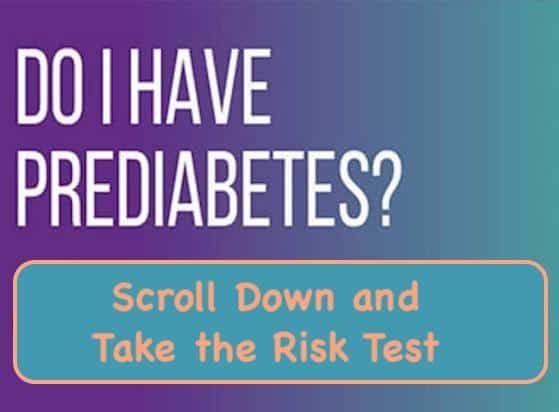
Updated May 28, 2022
A Prediabetes Quiz?
Yep, because according to functional medical expert Dr. Mark Hyman about 60 million Americans are prediabetic and don’t know it.
That’s more than one-fifth the population.
And yet, the good doctor underestimated the carnage.
Approximately 84 million American adults—more than 1 out of 3—have prediabetes. Of those with prediabetes, 90% don’t know they have it. Prediabetes puts you at increased risk of developing Type 2 diabetes, heart disease, and stroke.
The Diabetes Counsel puts the number at 86 million adults:
The relevant question is: Are you prediabetic?
Take the Prediabetes Quiz to find out.
Article Highlights:
- Prediabetes is a problem, and there’s a one-in-three chance that this problem’s yours.
- The prediabetes quiz can show if you should test your blood sugar.
- Find out which tests to get to check your blood sugar levels.
- Learn what lifestyle changes can make a difference. Supplementing with Indian Gooseberry, for instance, can produce better outcomes than diabetes drugs, like Metformin.
Let’s dig in…
The Dangers of High Blood Sugar Explained
In case you’re wondering what all the fuss is about, prediabetes is a serious health condition whereby blood sugar levels are higher than normal and healthy, but not high enough yet to be diagnosed as Type 2 diabetes.
Nothing good happens when your blood sugar is too high.
The following video is among the best I’ve watched that explains blood sugar and insulin:
According to MedicineNet.com, sustained high blood sugar can result in:
- Heart and blood vessel disease, that can increase the risk of heart attack, stroke, and peripheral artery disease.
- Poor kidney function eventually leading to kidney failure.
- Nerve damage, that can lead to burning, tingling, pain, and changes in sensation.
- Eye diseases, including damage to the retina, glaucoma, and cataracts.
- Gum disease.
If those negative health outcomes doesn’t get your hair on fire, what about the deleterious impact of sustained high blood sugar on your lifespan?
In How to Measure and Fix Your Blood Sugar, I presented two graphs that show that your blood sugar level at age 50 can predict how long you’ll live — check out the red lines:
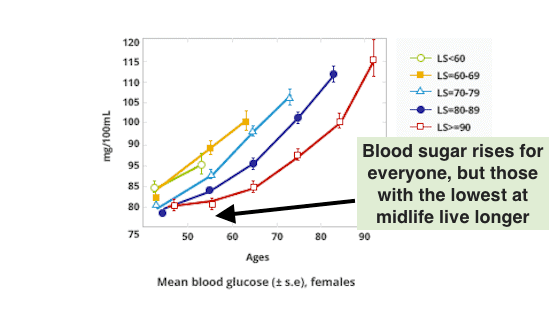
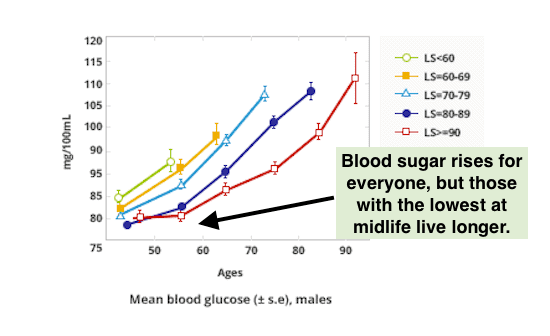 I hope I’ve captured your attention.
I hope I’ve captured your attention.
Let’s turn to symptoms, risk factors, and then give yourself a minute to take the Prediabetes Quiz.
Symptoms and Risk Factors
Both Type 1 and 2 share pretty much the same symptoms, although Type 1 occurs more often to people under 40 (usually present in childhood), and Type 2 to people over 40 who are usually also overweight. Other than that, they share these symptoms:
- Excessive thirst
- Excessive urination
- Thrush or genital itching
- Slow healing of wounds
- Blurred vision
- Lethargy
The CDC lists these risk factors:
- Being overweight
- Being 45 years or older
- Having a parent, brother, or sister with Type 2 diabetes
- Being physically active less than 3 times a week
- Ever having gestational diabetes (diabetes during pregnancy) or giving birth to a baby who weighed more than 9 pounds
- Having polycystic ovary syndrome
Among all the symptoms and risk factors, the most obvious is body weight.
You know if you’re overweight, but what you might not know is how much overweight you are and if it makes a real difference to your health.
Researchers studied over 900,000 participants in Japan, China, Taiwan, Korea, Singapore, Bangladesh and India and found a strong correlation with increasing Body Mass Index (BMI) and developing Pre-Diabetes or Diabetes.
A BMI of over 25 and the relative risk for these conditions increases. This is especially true in people younger than 50 years of age:
Here’s another look at how BMI and age relate to prediabetes; in this case from a cross-sectional study conducted in England between 2003 and 2011:
You can plainly see from the bar graph above that prediabetes correlates positively with age and BMI.
As I’ve reported, although BMI is the standard gauge of where you are along the continuum of underweight to obesity, it’s a flawed measure for some people, because it doesn’t account for muscle mass, at least not anything different from some average level. So, if you have extra muscle, your BMI number might show you’re overweight, as mine does, which comes in at 25.82, which is ranked as “overweight”. Despite what my BMI says, I’m not overweight. (Well, maybe five pounds.)
Taking that into consideration, use the widget below to calculate your BMI.
Supplied by BMI Calculator USA
Don’t fool yourself.
The temptation is to think that your BMI is high because you have more muscle than the average bear. But unless you regularly do some form of resistance exercise or work (calisthenics, weight lifting, walking up mountains with a back pack), your muscle mass is very likely to be average, or below average if the only surfing you do is on the couch.
Take the Prediabetes Quiz
This prediabetes quiz has been developed by the CDC. They don’t offer a widget to embed, so you either have to go here to take it on the CDC website, or click on the image below and add up your answers to the questions to get your score.
Don’t despair if your quiz result indicate that you’re prediabetic. If you do, you’re in good company and there’s a solution. 
Actor Tom Hanks revealed in 2013 that he’d been fighting high blood sugar since his thirties, and now has Type 2 diabetes.
And I reported my bewilderment and struggle with higher than ideal blood sugar in the articles My Blood Sugar Numbers Dumbfound Me, and Know Your Blood Sugar Numbers.
There are solutions to persistently high blood sugar, as you’ll soon see.
What Should Your Blood Sugar Numbers Be?
Different doctors and organizations suggest different thresholds with respect to the three relevant tests, which are:
- A1C
- FPG
- OGTT
Let’s look at each as described by the American Diabetes Association.
A1C
The A1C test measures average blood glucose for the past two to three months. The advantages of being diagnosed this way are that you don’t have to fast or drink anything.
| Result | A1C |
| Normal | less than 5.7% |
| Prediabetes | 5.7% to 6.4% |
| Diabetes | 6.5% or higher |
Fasting Plasma Glucose (FPG)
This test checks your fasting blood glucose levels. Fasting means after not having anything to eat or drink (except water) for at least 8 hours before the test. This test is usually done first thing in the morning, before breakfast.
| Result | Fasting Plasma Glucose (FPG) |
| Normal | less than 100 mg/dl |
| Prediabetes | 100 mg/dl to 125 mg/dl |
| Diabetes | 126 mg/dl or higher |
Note: In Europe and some other places, rather than measuring blood sugar using mg/dl (milligrams per deciliter,) mmol/L (millimoles per litre) is used. An easy way to make the conversion from mg/dl to mmol/L is to divide by 18. To convert mmol/L to mg/dl, multiply by 18.
Oral Glucose Tolerance Test (also called the OGTT)
The OGTT is a two-hour test that checks your blood glucose levels before and two hours after you drink a special sweet glucose drink. It reveals how your body processes glucose.
| Result | Oral Glucose Tolerance Test (OGTT) |
| Normal | less than 140 mg/dl |
| Prediabetes | 140 mg/dl to 199 mg/dl |
| Diabetes | 200 mg/dl or higher |
The numbers cited above are the standard suggested thresholds, but some doctors think they’re too liberal; meaning, that your numbers should be lower.
For instance, the aforementioned Dr. Mark Hyman recommends that:
Your blood sugar levels should be less than 80 mg/dl fasting and never rise above 110 or 120 mg/dl after one and two-hour checks.
Dr. Hyman is referring to ideal blood sugar numbers, not the prediabetic or diabetic threshold. The Life Extension Foundation puts the fasting number at below 86 mg/dl.
The odds are very strong that your fasting mg/dl is over the 80 to 86 range, but you can reduce yours to get it there if you’re willing to make some changes.
9 10 Ways To Lower Your Blood Sugar
If you have high blood sugar — and especially if your prediabetes quiz indicates that you may be prediabetic — you need to cut the things that are sending your biology out of balance and include what’s needed to help your body re-balance itself, says Dr. Hyman.
1. Eat whey before meals
Before I updated this post, I had a list of 9 ways to lower your blood sugar, but a recent study found that drinking a small serving of whey protein before meals could help people with type 2 diabetes control their blood sugars — so now there’s 10.
Understanding that someone with prediabetes does not have diabetes, I nonetheless think that consuming some whey protein before a meal could help.
Results from continuous glucose monitoring device worn by participants in the study showed that their glucose levels were much better controlled when taking the whey supplement before meals. On average, participants had two hours extra per day of normal blood sugar levels compared to those not ingesting the whey protein. Additionally, their daily blood glucose levels were 0.6 mmol/L (10.81 mg/dL) lower compared to when they consumed the control supplement without any protein.
The researchers believe that whey protein works in two ways:
- Slows down how quickly food passes through the digestive system, and
- Stimulates a number of important hormones that prevent the blood sugars from climbing so high.
The suggested amount of whey protein:
15 grams in water before each meal.
If you can tolerate whey, look for a reputable brand that is made from grass-fed cows. I use Levels.
2. Eat whole, fresh foods.
Food is information that controls your gene expression, hormones, and metabolism. Choose low-glycemic real foods including fresh vegetables, fruits, legumes, non-gluten grains, nuts, seeds and high-quality animal protein.
3. Remove all sweeteners.
Artificial sweeteners can raise insulin levels and contribute to insulin resistance. One study in the journal Diabetes Care found sucralose (Splenda) could raise glucose and insulin levels. Give up sugar, and also stevia, aspartame, sucralose, sugar alcohols like xylitol and malitol — they can all slow down your metabolism, encourage gain weight, and increase insulin resistance, says Dr. Hyman.
4. Control inflammation.
Dietary sugars and refined vegetable oils are the biggest contributors to inflammation. They increase insulin levels and turn on genes that lead to chronic inflammation, creating a downward spiral into more inflammation, poor blood sugar control, and chronic disease. Besides removing the offending foods, address food sensitivities and allergies to control inflammation. Incorporate plenty of anti-inflammatory foods including wild-caught fish, freshly ground flax seed, and fish oil.
(Check out Dr. Andrew Weil’s anti-inflammation pyramid.)
5. Increase fiber-rich foods.
Our Paleolithic ancestors got 50 – 100 grams of fiber a day. These days, we average a paltry 15 grams, or less. Studies show high-fiber foods can be as effective as diabetes medications to lower blood sugar without the side effects. Fiber slows sugar absorption into the bloodstream from the gut. Eat a variety of fiber-rich plant-based foods including nuts, seeds, fruits, vegetables, and legumes. You can also supplement with PBX or psyllium seed powder.
6. Get enough sleep.
A study in The Journal of Clinical Endocrinology and Metabolism found in healthy subjects, even a partial night of poor sleep contributes to insulin resistance. Make sleep a top priority to normalize insulin levels. Avoid eating three hours before bed and take what Dr. Hyman calls an UltraBath to raise your body temperature and relax your muscles. (Two cups of Epsom salts, half a cup of baking soda, 10 drops of lavender oil, and you soak for 20 minutes.) Go to bed and wake up at consistent times, only use your bed for sleep and sex, and try herbal therapies or melatonin.
(Read my article about amazing melatonin.)
7. Address nutrient deficiencies.
A number of nutrients play a role in insulin management, including vitamin D, chromium, magnesium, and alpha lipoic acid. Deficiencies in any nutrient can stall your biochemical machinery, knocking your blood sugar levels out of balance and making you more insulin resistant.
(Read about the powerful group of blood sugar supplements I take.)
8. Incorporate the right exercise.
Exercise might be the most powerful medicine to manage blood sugar levels and make your cells more insulin sensitive. When it comes to exercise, time becomes a huge hurdle for many people. If that’s your issue, try HIIT. High Intensity Interval Training, also called burst training, can be done in just 20 minutes. A study in the Journal of Obesity found among its other benefits,burst training helped decrease fasting insulin and reduce insulin resistance. Combining burst training with weight resistance provides the most effective, efficient way to normalize blood sugar and insulin levels.
(Read my article, HIIT It Hard for Your HGH Boost.)
9. Control stress levels.
Chronic stress elevates cortisol, your main stress hormone. Increased cortisol levels elevate blood sugar and promote the accumulation of belly fat seen in people with insulin resistance or diabetes. You can’t eliminate stress, but you can reduce its impact. Find what works for you. That might be meditation, yoga, deep breathing, or exercise.
(Read Why Stress Is The Greatest Super-ager Of Them All)
10. Supplement with Indian Gooseberries and Berberine.
I’ve added these two to Dr. Hyman’s mix of suggestions simply because their effect on lowering blood sugar is stunning!
Also called “Amla”, Indian Gooseberry is a powerful fruit typically offered as a powder that, along with Berberine, might be the biggest bang for your blood sugar lowering buck. Dr. Michael Greger of NutritionFacts.org says:
Am I recommending people treat their diabetes with gooseberry powder? No, I recommend curing your diabetes… Why treat anything when you get at the root cause and reverse it in the first place.
This graph says it all:
The red line above represents a common diabetes drug (glyburide), and the blue line is Amla.
Dr. Greger says that even taking one-quarter of a teaspoon a day can normalize blood sugar. Currently, I’m using Feel Good Organic Amla Powder.
Now lets turn to Berberine.
The president of Stop Aging Now, Joshua Corn, writes about a double-blind, placebo-controlled trial investigating the effect of berberine on blood sugar and lipid levels in 110 middle-aged subjects with impaired glucose control and raised cholesterol and/or triglycerides.
Subjects took either 1,000 mg of Berberine daily or a placebo for three months. Researchers found that those taking Berberine had significant improvements, including a:
- 20% reduction in fasting glucose.
- 26% reduction the two-hour oral glucose tolerance test (the measurement of after-meal glucose levels).
- 36% reduction in triglycerides.
- 18% reduction in total cholesterol.
- 21% reduction in LDL cholesterol.
So, Berberine not only improves blood sugar, but cholesterol as well.
Check out the graph:
Here’s what to do:
- Take 500 mgs of Berberine twice per day; and
- Take a teaspoon of Amla powder twice per day.
Alaska Paves The Way
If you have any doubts how effective lifestyle changes can be, consider what Alaska is doing.
Alaska has an online program for reducing the incidence of prediabetes and diabetes. It guides participants in making some of the basic lifestyle changes enumerated above.
Here are the outcomes:
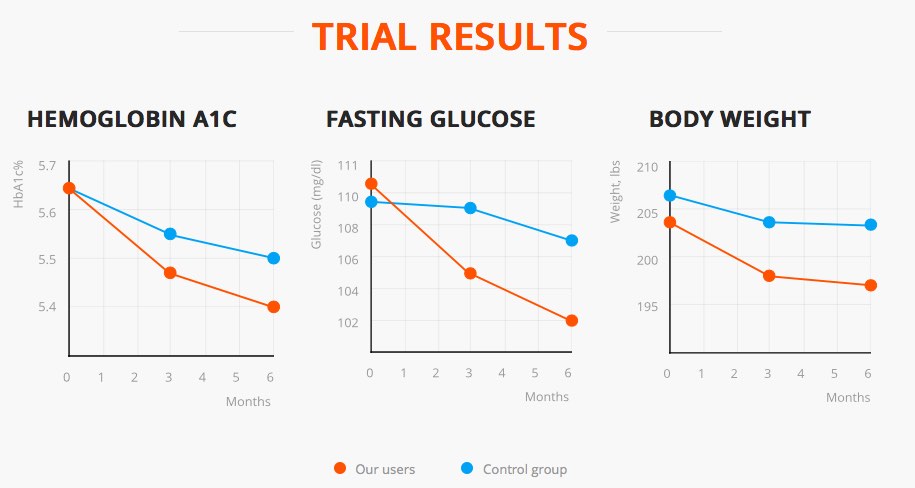
Notice how much better the program’s participants (red) do than those who don’t follow the program (blue). Big difference. Shows you what’s possible.
Your Takeaway
There’s a lot to unpack here, so let’s do it.
Remember these four things:
- You have a one-in-three chance of being prediabetic, which means you’re on your way to getting adult onset, Type 2 diabetes, which will dramatically compromise your health and likely shorten your lifespan.
- You can take the Prediatetes Quiz to get a sense if you’re at risk. If you are, get a blood test and have a conversation with your doctor.
- Don’t despair too much, because various lifestyle interventions can help enormously, particularly supplementation with Amla and Berberine, as presented above.
- One thing not mentioned until now, but very important is that any new set of behaviors you wish to incorporate in your life have a greater chance of becoming habitual if you recruit the help of friends. Hang out with those who already emulate what you wish to become.
Last Updated on August 12, 2022 by Joe Garma

